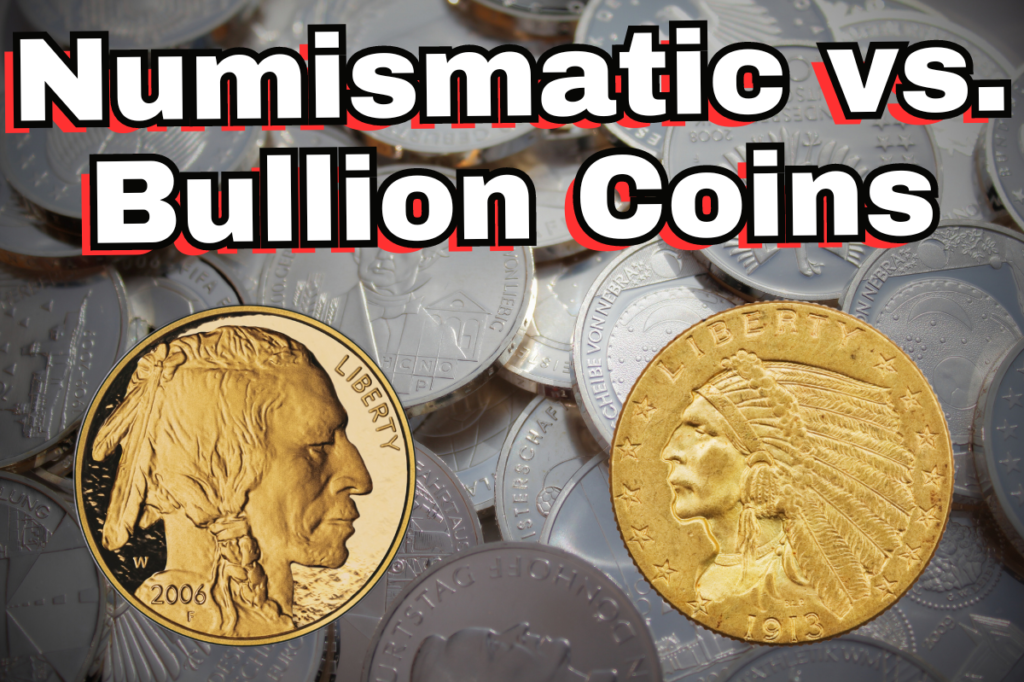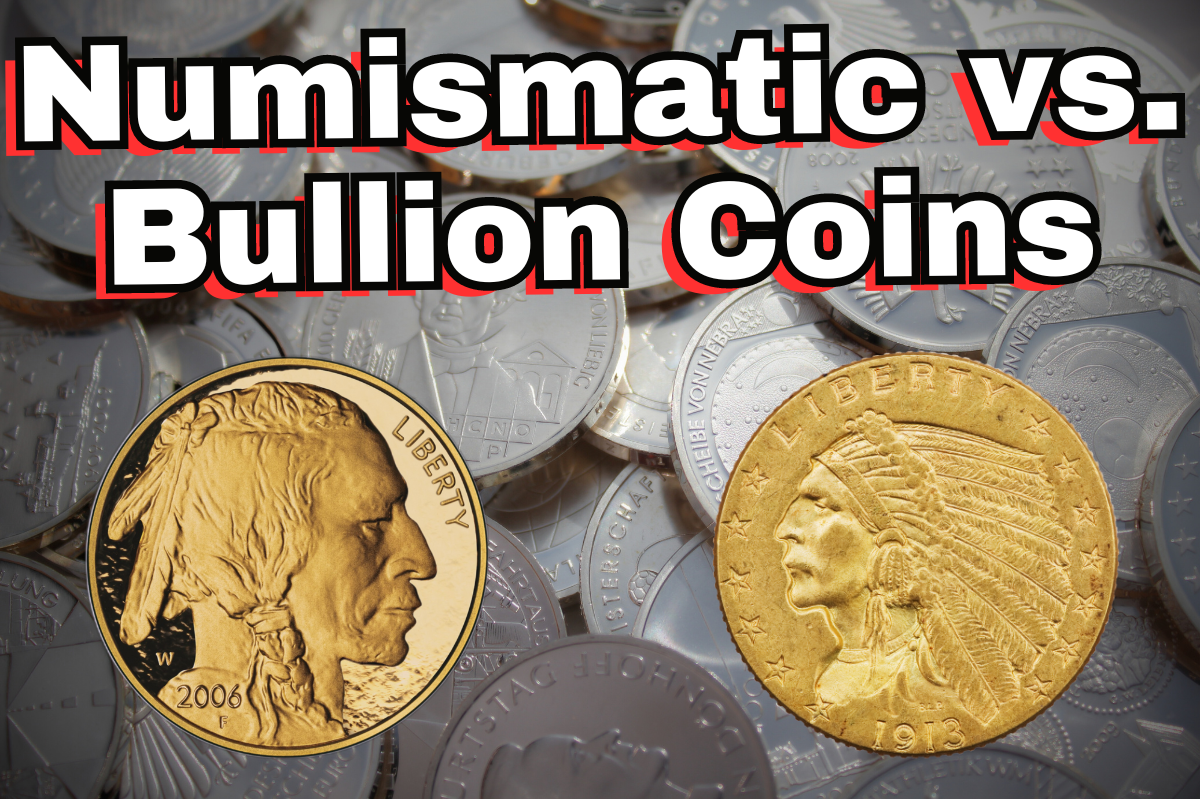Are you considering investing in precious metals but are uncertain about how to get started?
This article will offer guidance on the fundamentals of bullion and numismatic coins. It defines bullion, examines the different types that are on the market, and highlights the main distinctions between bullion and numismatic coins.
An overview of numismatic coins is presented, including a discussion on their value determinants, along with a comparison of the advantages and disadvantages of investing in bullion versus numismatic coins.
Continue reading to discover the intricacies of these investment alternatives.

Key Takeaways:
-
- Bullion coins are primarily valued for their metal content, while numismatic coins are valued for their rarity, historical significance, and collector demand.
-
- The value of bullion coins is largely tied to the market price of the metal they are made of, while the value of numismatic coins can be influenced by a variety of factors, including condition, mintage numbers, and collector interest.
-
- When investing in coins, it is important to understand the key differences between bullion and numismatic coins, and to consider your investment goals and risk tolerance when deciding which type to purchase.
Understanding the basics
Exploring the realms of bullion and numismatic coins involves recognizing the key differences between these two categories. Bullion coins are primarily valued for their metal content and investment potential, while numismatic coins have additional value stemming from their rarity or historical significance.
Bullion coins, such as gold, silver, and platinum coins, derive their worth from the market price of the precious metal they contain. Those who invest in bullion typically seek a direct investment tied to the intrinsic value of the metal.
Conversely, numismatic coins are valued not only for their metal content but also for factors like age, condition, and historical context, making them highly desirable to collectors. These distinctions are pivotal in determining the appeal of each coin type to various market segments.
What is Bullion?
Bullion encompasses precious metals like gold and silver that are minted and primarily sold based on their metal content value rather than rarity or historical importance. These coins are favored by investors looking for a tangible asset to protect against economic uncertainties and preserve wealth.
Investors often choose bullion coins for their inherent value and ease of liquidity. Common types of bullion coins include American Eagles, Canadian Maple Leafs, and South African Krugerrands, each with its own unique design and purity characteristics. Bullion coins usually display their weight and purity through stamping, offering transparency and reassurance to investors.
These coins are valued not only for their investment potential but also for their legal tender status in the countries of minting, enhancing their overall appeal as a strategic investment option in the realm of precious metals.
Definition and types
Bullion coins are available in various forms, such as gold and silver options produced by well-known institutions like the Perth Mint, American Eagle series, and offerings from the US Mint. Each type holds its own intrinsic value determined by metal purity and weight, making them appealing to both investors and collectors.
Gold bullion coins are commonly crafted from 22-karat or 24-karat gold, with popular selections including the American Gold Eagle and the South African Krugerrand. On the other hand, silver bullion coins like the Canadian Silver Maple Leaf and the Austrian Silver Philharmonic often consist of .999 fine silver, adding to their attractiveness among collectors seeking high-quality pieces. The variety in design among bullion coins enables collectors to pick coins that align with their interests, whether related to historical figures, iconic landmarks, or national symbols.
Differences Between Bullion and Numismatic Coins
Understanding the differences between bullion and numismatic coins is important for investors looking to navigate the world of precious metals effectively. Bullion coins derive their value primarily from the metal content, while numismatic coins hold additional worth due to factors like rarity, historical significance, and collector demand.
Bullion coins are valued based on the weight and purity of the precious metal they contain, making them a popular choice for those seeking a direct investment in gold, silver, or other metals. On the other hand, numismatic coins are more appealing to collectors and history enthusiasts, as their worth encompasses not only the intrinsic metal value but also the coin’s design, age, and condition.
This dual nature of numismatic coins as both an investment and a piece of history sets them apart, attracting buyers who appreciate the blend of artistry and legacy in their collection.
Exploring key variances
Numismatic coins are distinct from bullion coins in that their worth goes beyond the metal they contain, considering factors like rarity, condition, historical significance, and collector demand. Having a grasp of these differences is crucial for investors aiming to make well-informed choices in the precious metals market.
While bullion coins mainly derive their value from their metal content, numismatic coins are valued not only for the precious metals they hold but also for their individuality and historical context. Numismatic coins often command a premium due to their limited production, aesthetic appeal, and sometimes their association with specific historical events or figures. Collectors are attracted to numismatic coins for their beauty, craftsmanship, and the narratives they embody, contributing to a lively market where prices can be influenced by factors beyond just the metal’s spot price.
Numismatic Coins: An Overview
Numismatic coins are a distinct type of collectible coins highly valued for their rarity, historical significance, and condition. These coins appeal to collectors interested in the craftsmanship, historical context, and cultural importance associated with each piece, blending investment potential with aesthetic appeal.
The attraction of numismatic coins lies in their capacity to recount stories of the past through detailed designs and engravings, transforming them into tangible pieces of history. Their worth often exceeds the intrinsic metal value, with factors like minting mistakes, limited editions, and popular themes increasing their desirability. Numismatic coins offer a way to diversify an investment portfolio, providing a safeguard against economic uncertainties while also offering an engaging and educational hobby for enthusiasts interested in exploring the field of numismatics.
Definition and value factors
Numismatic coins cover a broad spectrum of collectible pieces that hold unique historical and cultural importance. Their value is influenced by various factors like rarity, condition, age, historical context, and demand from collectors, making them an intriguing area of interest for both numismatists and investors.
These coins serve not only as tokens of monetary exchange but also as gateways to the past, carrying stories of civilizations, rulers, and events that have shaped history. Rarity is a key factor in determining the value of numismatic coins, as items with limited availability tend to be more sought after by collectors. The historical circumstances surrounding a coin’s minting can significantly affect its value, with pieces from significant eras or featuring iconic designs often commanding higher prices in the market. Collector interest further influences the value of these coins, as enthusiasts aim to create curated collections that highlight the diversity and beauty of numismatic art.
Investing in Bullion vs. Numismatic Coins
When considering whether to invest in bullion or numismatic coins, individuals should carefully assess their investment objectives, risk tolerance, and personal preferences.
Bullion coins are typically minted primarily for their metal content and weight, with their value linked to the current market prices of metals like gold, silver, platinum, or others they contain. This characteristic makes them a more straightforward investment option for individuals looking for direct exposure to the changing prices of precious metals.
On the contrary, numismatic coins, while also including precious metals, hold added value from factors such as rarity, historical significance, condition, and collector demand. This additional value makes them attractive to individuals interested in the artistic and historical aspects of coinage.
Pros and cons of comparison
Investing in bullion coins provides a direct exposure to the value of precious metals, serving as a hedge against economic uncertainties and inflation. On the other hand, numismatic coins offer potential appreciation opportunities based on rarity, historical interest, and collector demand, although they come with higher price volatility.
Bullion coins are typically valued according to the weight and purity of the metal they contain, making them perceived as a more stable investment choice due to their intrinsic value. Investors looking for a tangible asset that mirrors the market value of gold, silver, or other precious metals may find bullion coins attractive.
In contrast, numismatic coins are valued not only for their metal content but also for their rarity, age, condition, and historical significance. While numismatic coins may present the potential for high returns based on collector demand and market trends, they also carry the risk of fluctuating values influenced by factors beyond metal prices.
Summarizing the nuances
The exploration of investing in bullion and numismatic coins highlights the delicate balance between the appreciation of tangible assets and historical significance. Bullion coins provide stability through their metal content, while numismatic coins offer an added layer of cultural and historical value, presenting a diversified investment strategy for collectors and investors.
Bullion coins are typically valued based on their precious metal content, such as gold, silver, or platinum, and are esteemed for their intrinsic value. Investors frequently opt for bullion coins as a means to hedge against economic uncertainties or as a tangible form of wealth storage.
On the contrary, numismatic coins attract collectors because of their rarity, historical importance, and aesthetic appeal. Collectors find joy in searching for unique pieces with compelling stories, often seeing these coins as miniature works of art that encapsulate a fragment of history.
Frequently Asked Questions
What is the difference between bullion and numismatic coins?
Bullion coins are typically made from precious metals such as gold, silver, or platinum and are valued primarily for their metal content. Numismatic coins, on the other hand, are valued for their rarity, historical significance, and collectibility.
Are bullion coins and numismatic coins both considered investments?
Yes, both types of coins can be considered investments, but for different reasons. Bullion coins are often seen as a way to diversify a portfolio and protect against inflation, while numismatic coins are more commonly collected for their potential to increase in value over time.
How do the prices of bullion and numismatic coins differ?
The price of a bullion coin is primarily determined by the current market value of the metal it is made from. Numismatic coins, on the other hand, can have a wide range of prices depending on their rarity, condition, and demand from collectors.
Which type of coin is a better option for long-term investment?
This depends on your investment goals and risk tolerance. Bullion coins are generally seen as a more stable option, while numismatic coins can have a higher potential for growth but also come with higher risk.
Can bullion coins be considered collectible as well?
While bullion coins are primarily valued for their metal content, some designs or limited edition releases can also hold collectible value. However, they are not typically as sought after by collectors as numismatic coins.
Are there any tax differences between bullion and numismatic coins?
In the United States, bullion coins are not considered collectibles and are subject to a higher capital gains tax rate. Numismatic coins, however, are treated as collectibles and may qualify for a lower long-term capital gains tax rate.




